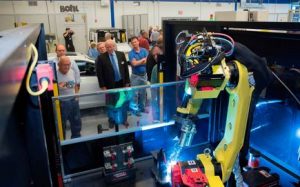 Myth busting: A look at some of the misconceptions around robotic welding
Myth busting: A look at some of the misconceptions around robotic welding
December 10, 2014 REDWIRE is news you can use from leading suppliers. Powered by FRASERS.
Posted by Lincoln Electric (Canada)
World Leader in the Design & Manufacture Of Arc Welding Equipment & Consumables, Robotic/Automation Welding Solu... Read more
Subscribe
Free REDWIRE e-newsletter

Automated welding represents an opportunity for improvement to many in the industry, but not everyone is convinced. Part of this unease stems from misconceptions about the process.
Lincoln Electric addressed some of these misconceptions in a recent article — “Is automation worth the investment for welding applications?” — but there are many more myths, and the company would like to set the record straight.
Misconception: Robots are too expensive
Consider just a few of the many cost justifications before you buy into this myth: Robot use means decreased labour rates, increased productivity and volume, the elimination of variability, and reduced filler metal costs. What’s more, thanks to the availability of pre-engineered welding work cells, the actual cost of robotic welding systems has decreased over the years. And robot arms also are becoming more affordable. With these costs decreasing and labour rates climbing, it’s worth assessing if robotic welding is right for your operation.
Misconception: It’s too complicated to integrate into my operations
Thanks to pre-engineered and custom-cell solutions, integration has become much easier — even if you want to automate only a portion of your operations. It all comes down to choosing the right option for your product mix and welding needs by defining the scope of your applications, and deciding where you plan to implement automated welding within your manufacturing process. To do this, you’ll first want to assess the parts you manufacture and ensure they are suited for automated welding. If you have a lot of part variation or inconsistent fit-up, you’ll have to address those issues before you automate. Also, take a look at your weld joints’ accessibility. How easy is it for a robot to reach them and successfully complete all necessary welds?
Misconception: Robots are too difficult/time-consuming to use
This simply isn’t true. Options for offline programming, human machine interface and such intelligent solutions as vision and laser tracking help provide easy implementation.
Misconception: You can weld everything with a robot
While robotic welding is right for some applications and operations, it isn’t a cure all for every welding process or challenge. Some applications simply are not a good fit for automation. For example, outside manufacturing operations, parts or weld joints that a robot can’t reach and space-constrained applications are not ideal for robotic welding.
The bottom line
When robotic welding is correctly integrated into an overall manufacturing strategy, it can increase productivity and profits. It also gives workers an opportunity to develop new skills and knowledge.
To learn whether robotic welding is right for you, contact Lincoln Electric.
Share
Posted by Lincoln Electric (Canada)
World Leader in the Design & Manufacture Of Arc Welding Equipment & Consumables, Robotic/Automation Welding Solu... Read more